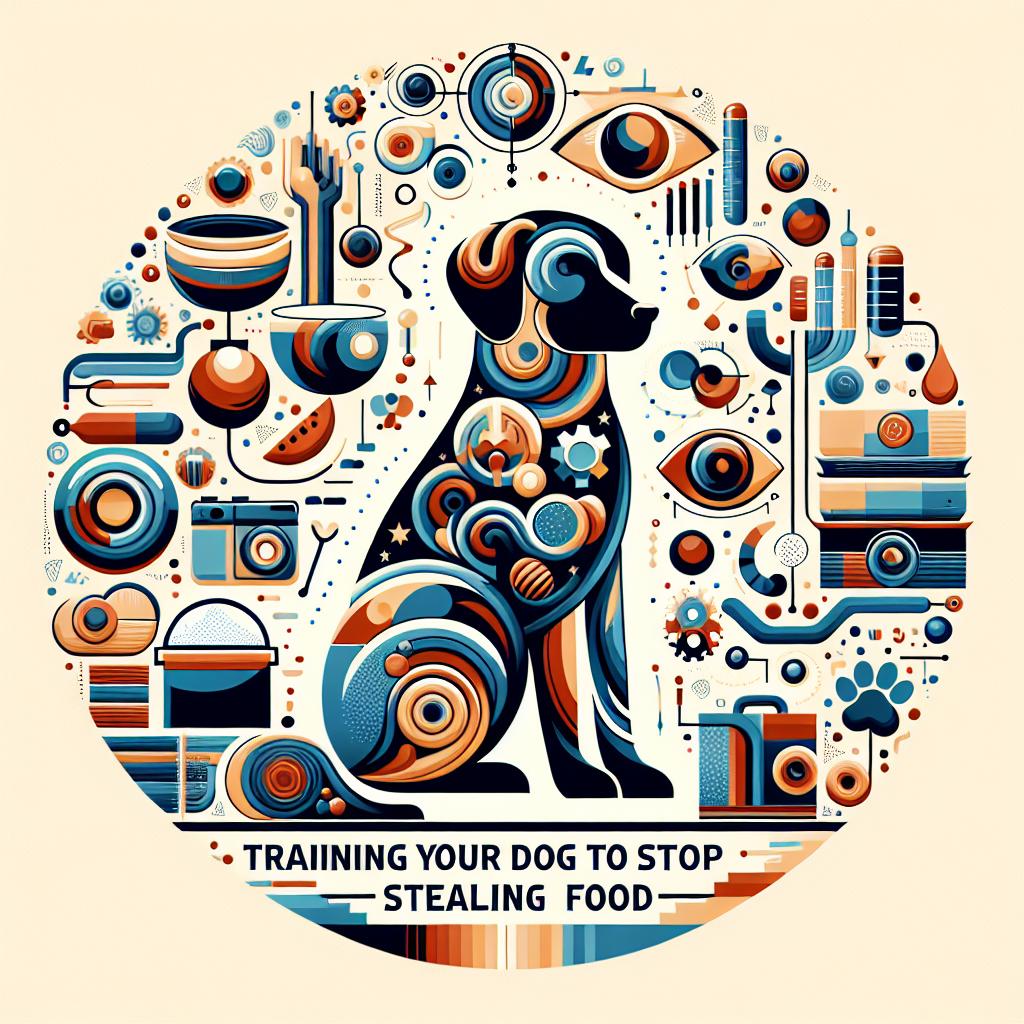Introduction:
Picture this: you’ve just prepared a delicious meal, the aroma wafting through your kitchen, tantalizing your senses. As you set the table, a pair of eager eyes watches your every move, tail wagging in anticipation. Suddenly, you turn your back for just a moment, and before you know it, your beloved canine companion has made off with a mouthful of your carefully crafted dish! If this scenario sounds all too familiar, you’re not alone. Many pet owners grapple with the challenge of teaching their dogs to resist the temptation of food stealing. Though our furry friends’ antics can be amusing, this habit can lead to unhealthy eating patterns and a less harmonious home. In this article, we will explore effective training techniques and strategies to help curb your dog’s food thievery, ensuring mealtime remains a joyful experience for everyone involved. Discover the steps you can take to transform your four-legged foodie into a well-mannered dining companion.
Understanding the Root Causes of Food Theft in Dogs
To effectively train your dog to stop stealing food, it’s essential to understand the underlying reasons for this behavior. Dogs may engage in food theft due to instinctual behaviors inherited from their ancestors, who relied on scavenging for survival. Common root causes include:
- Hunger: If your dog is not receiving enough nourishment during regular feeding times, they may resort to stealing food as a means of satisfying their appetite.
- Boredom: Dogs that lack mental or physical stimulation might look for excitement by seeking out food sources, effectively turning food theft into a form of entertainment.
- Attention-Seeking: Some dogs learn that stealing food grabs their owner’s attention, even if it’s negative, thus reinforcing the behavior.
Additionally, certain environmental factors and household dynamics can contribute to food theft. Consider the following aspects that might influence your dog’s behavior:
| Factor | Impact on Behavior |
|---|---|
| Accessibility: | Easy access to food (like open garbage cans) encourages stealing. |
| Family Dynamics: | Multiple family members may unwittingly reinforce this behavior by sharing food or being inconsistent with training. |
| Proper Training: | Lack of structure and commands can lead to confusion and food theft. |
Effective Training Techniques to Curb Food Stealing Behavior
Establishing a strong foundation of obedience in your dog is crucial to deter any food stealing tendencies. One effective training technique is the “Leave It” command, which teaches your dog to ignore food or other tempting items. Start by holding a treat in your closed fist and allowing your dog to sniff it. Once they lose interest or step back, praise them and reward with a different treat. This reinforces the idea that ignoring the temptation results in a reward. Repeat this exercise with treats on the floor, gradually increasing the difficulty as your dog learns to resist temptation.
Another valuable strategy is to reward alternative behaviors. Instead of simply reprimanding your dog for stealing food, proactively redirect their attention. Set up a designated area, such as a mat or bed, and encourage your dog to go there when they feel tempted. Use positive reinforcement techniques, such as treats and praise, when they adhere to this new behavior. Additionally, maintaining a consistent routine and ensuring your dog has plenty of mental and physical activity can significantly reduce their inclination to steal food, as boredom often drives unwanted behaviors.

Creating a Structured Environment for Successful Food Management
To ensure a harmonious relationship between your dog and your kitchen, establishing a structured environment is fundamental. Dogs thrive on routine, so incorporating designated areas for food storage and preparation can help in minimizing distractions. Here are some strategies to implement:
- Designate a Safe Zone: Create a specific area where your dog is allowed during meal prep. Use baby gates or dog crates to help keep them safely separated.
- Consistent Meal Schedule: Feed your dog at the same times each day to build their understanding that food is provided by you, not stolen from the counter.
- Positive Reinforcement: Reward them for following your rules with treats and praise, reinforcing the behavior you want to see.
Additionally, it’s important to optimize your kitchen space to discourage food theft. Organizing your food items in a way that limits access can significantly reduce temptations. Consider these tips:
- Store Food Securely: Use airtight containers and secure cabinets to keep your dog out of reach of tempting food items.
- Positioned Surfaces: Keep food items on higher surfaces, out of jumping reach, to diminish the possibility of theft.
- Engagement During Meal Prep: Keep your dog engaged with toys or puzzles while you cook to divert their attention and create a positive association with their own playtime.

Reinforcing Positive Behavior through Rewards and Consistency
To effectively curb your dog’s food-stealing tendencies, it’s crucial to implement a system of rewards that reinforces desired behavior. Start by teaching your dog the “leave it” command, a powerful tool that can redirect their attention away from tempting food. When your dog successfully ignores food that’s been dropped or placed within reach, immediately reward them with praise, head pats, or a favored treat. This consistency helps your dog connect the action of ignoring food with enjoyable rewards, making it less likely they’ll venture to snatch inappropriate snacks in the future.
Establishing a routine reinforces positive behavior as well. Provide meals at regular times and use a designated spot for feeding. This way, your dog learns when they will receive their food and can start to understand that stealing food isn’t necessary. Below are some strategies to consider:
- Scheduled Feedings: Stick to a routine to minimize the chances of random food exposure.
- Controlled Environments: Use baby gates or crates to restrict access when food is not intended for them.
- Positive Reinforcement: Consistently reward good behavior with treats, toys, or affection.
Q&A
Training Your Dog to Stop Stealing Food: Q&A
Q1: Why do dogs steal food?
A1: Dogs are naturally driven by their instincts, and scavenging for food is one of them. If they’ve had success in the past stealing tasty morsels, they quickly learn that it’s worth the effort! Additionally, smells and curiosity can often get the better of them causing them to explore tables, counters, and anywhere they might find a snack.
Q2: How can I prevent my dog from stealing food?
A2: Prevention is key! Start by keeping food out of reach. Utilize baby gates or close doors to limit access to areas where food might be left unattended. You can also create a designated “dog-free” zone in your kitchen or dining area. Consistently reinforcing your dog’s boundaries will help deter them from wandering into food theft territory.
Q3: What training methods are most effective?
A3: Positive reinforcement is often the most effective method. When your dog successfully ignores food or shows self-control, reward them with praise, treats, or playtime. Commands like “leave it” can be powerful tools when taught consistently. Start practicing with less enticing items before progressing to the real deal!
Q4: How do I teach the “leave it” command?
A4: To teach ”leave it,” hold a treat in your closed fist and let your dog sniff it. When they stop trying to get it and back off, reward them with a different treat from your other hand. Repeat this until they consistently offer you their attention rather than the treat. Gradually increase difficulty by placing treats on the floor while giving the “leave it” command!
Q5: What if my dog already has a habit of stealing food?
A5: If food stealing has become habitual, it will take time and patience to retrain your dog. Identify and address the triggers for their behavior, whether it’s an unattended meal or a specific person leaving food out. Employ consistent training methods and be sure to monitor their progress. Remember, breaking an old habit is challenging, but with dedication, improvement is possible!
Q6: Are there any distractions I can use during mealtime?
A6: Yes! Redirecting your dog’s energy can be effective. Consider providing a special dog toy filled with treats or peanut butter during mealtime to keep them occupied. This not only distracts them from the food but also reinforces positive behavior by rewarding them with their own yummy surprise.
Q7: How long will it take to train my dog to stop stealing food?
A7: The timeline can vary significantly based on your dog’s personality, age, and history with food stealing. Some dogs may learn quickly, within a few weeks, while others might take a few months. Consistency, patience, and persistence are vital; every small step toward improvement is a victory!
Q8: When should I seek professional help?
A8: If you find that your dog’s behavior is aggressive or compulsive when it comes to food stealing, it may be time to consult a professional dog trainer or behaviorist. They can provide personalized strategies and insights that can enhance your training efforts. Remember, it’s always better to be safe than sorry with issues that may affect your dog’s well-being or your family’s safety.
By addressing the underlying instincts driving your dog’s behavior, implementing preventative measures, and incorporating effective training techniques, you can cultivate a harmonious environment that allows you to enjoy meals without the thief sneaking in for a taste!
Insights and Conclusions
As we wrap up our exploration into the art of training your dog to resist the temptation of snatching food from countertops and tables, remember that patience and consistency are your best allies. The journey to a well-mannered pup may have its challenges, but the rewards of a harmonious home and stress-free mealtimes are well worth the effort. By employing the strategies outlined in this article—establishing boundaries, reinforcing good behavior, and utilizing distractions—you create a lasting foundation of respect and understanding between you and your furry companion.
So, as you embark on this training adventure, keep in mind that every small victory counts. Celebrate progress, be compassionate in moments of mischief, and above all, foster the bond that makes your relationship with your dog uniquely rewarding. With dedication and love, you can transform your four-legged friend into a model citizen of your household—one who understands that the delicious offerings on your table are off-limits, but that their own special treats will always come from you. Happy training!

